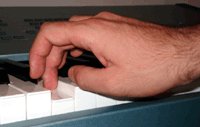How to Practice Music Scales
Home » Piano Theory » How to Practic Music Scales
Now that we've learned how to form all 12 major scales I'd like to talk about how to practice them.
These exercises I will show you have a few targets:
- To form our hand in the correct posture while moving on higher and lower on the on the piano.
- We're gonna learn the logic behind finger settings which we will test through playing the different scales.
- Getting familiar with all music scales will give us a hugh advantage when we play any piece or when we improvise. (Knowing our way on the piano is a great time saver).
- Working on these music scales is a ticket to improve our motor skills and allow us to play faster, smoother, and create a beautiful sound.
Every Day Exercises
Here's my suggestion on how to practice the music scales.
These exercises are called E.D exercises which are the initials for Every Day exercises.
The idea behind performing these exercises is to play them every day of course, five minutes long.
These exercises are supposed to be played slowly at first
in order to give us perspective on the way our body performs motor actions. After we refined our movements we can start performing these exercises faster.
However, we shouldn't bother about that too much since it happens automatically.
Just like learning to drive a car.
When we play E.D exercises we do it in the following order:
- Right hand
- Left hand
- Counter movement (By placing both your thumbs on the same key and moving in opposite direction by playing the same fingers in both hands)
- Parallel movement (Both hand are playing the same note but using different fingers while moving in the same direction).
Right Hand
The basic right hand fingering for music scales when playing two octaves is:
1 2 3, 1 2 3 4, 1 2 3, 1 2 3 4 5
Then we go back keeping the same fingerings.
Why these fingerings?
We work with finger sets. Our first three fingers are stronger then our fourth and fifth fingers so we concentrate on using these as much as possible. What we basically do is moving in set of 3's and 4's.
When we play we should keep our hand round as if it holds a bubble. The fingers should be round and when we play we have to play only with the tip of the pillow of our finger. It's important not to break our fingers since by doing so we hold the energy from flowing into the piano.
Round movement is the key to keeping and creating energy and volume if you want to play piano without straining your muscles and causing damage to your body.
For that same reason it's important to keep the pulse loose.
We don't wanna smash the bubble we're holding.
The round hand has another important roll which we're going to talk about
in the next element of these exercises.
Cross Over

The cross over is the action we take when we switch our thumb under the third finger after the first set of fingering in our exercise (1 - 2 - 3).
It's important to keep our hand round while doing so or the thumb won't have space to cross over while playing music scales.
The thumb is different from the other fingers. It's lying on its side and therefore it can move smoothly under the third or fourth finger (in second set 1 - 2 - 3 - 4 ) without moving the hand more than necessary. Keep that in mind while performing these exercises.
When we go down the music scale and it's time to cross over we raise the third or fourth finger above the thumb. This is possible again only when the hand is round. It's done without moving the hand from its positioning and without straining it. The pulse should be loose.
Left Hand
The left is hand exercise is performed with the same notes, only with parallel fingerings. Here is the fingering for the left hand.
5 4 3 2 1, 3 2 1, 4 3 2 1, 3 2 1
Counter Movement
In counter movement we place both thumbs on the root note (for example: Middle C on C major) and then we move in a counter movement. So, both hands are always playing the same finger. (In C major the next action would be playing D on the right hand and B on the left hand with the second finger).
This is the next step since now we have to perform the crossover on both hands but they are performed in the same time.
Parallel Movement
In the parallel movement things are getting a bit more complicated when practicing music scales since now we have to use different fingers for each finger.
We start with the first finger on middle C on the right hand and
with the fifth finger on lower C in the left hand.
Then we go on both hands to D. The right hand is playing with
the second finger and the left hand is playing with the fourth finger.
We continue the way until we have to crossover in the right hand from E to F.
The left hand is continuing as usual. When we go from G to A it's the left
hand turn to crossover with the third finger so that when we play
the A note both hand are playing with the third finger.
This diagram will help you get the fingering right when practicing.
The first part of this list contains The major piano scales that have this common fingering. the arrow is a sign for cross over.
Click here to get a free printable page of the counter and parallel movements of the major scales.
Starting with a Black Key
The fingering story changes when our scale starts with a black key (F#, Bb, Ab etc...).
It's uncomfortable to start with the first finger on a black key.
What we usually do is start with the second finger (R.H)
and cross over when we have the opportunity and a white key is coming in our way.
This list below contains the counter movement of the scales that have an exception and the parallel movement of all 12 major scales. I suggest you print it and it will help you to practice scales faster.
If you havn't checked the list I've made you take a look at the counter movement part.
If you haven't checked it yet, Click here to get a free printable page of all the parallel and counter movements of the major scales.

One of the main reasons to learn the secrets of music scales is to be able understand how chords are created in the concept of a scale and to be able to improvise upon these chords while using the right scale. You probably find it problematic to learn to play so many scales and practically use them while playing, but luckily I have found a great solution for you.
Rocket Piano provide a great course on how to improvise with scales effectively.
This is just one of the great piano courses they have in the Rocket Piano
Ultimate Piano Learning Kit. Regarding piano theory Rocket Piano have an
amazing method that will get you there like no other piano teacher would.
Click here to check out the Rocket Piano Ultimate Piano Learning Kit.














